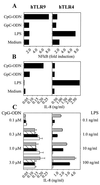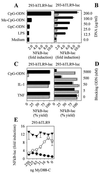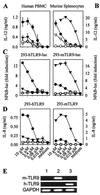Human TLR9 confers responsiveness to bacterial DNA via species-specific CpG motif recognition
- PMID: 11470918
- PMCID: PMC55404
- DOI: 10.1073/pnas.161293498
Human TLR9 confers responsiveness to bacterial DNA via species-specific CpG motif recognition
Abstract
The Toll-like receptor (TLR) family consists of phylogenetically conserved transmembrane proteins, which function as mediators of innate immunity for recognition of pathogen-derived ligands and subsequent cell activation via the Toll/IL-1R signal pathway. Here, we show that human TLR9 (hTLR9) expression in human immune cells correlates with responsiveness to bacterial deoxycytidylate-phosphate-deoxyguanylate (CpG)-DNA. Notably "gain of function" to immunostimulatory CpG-DNA is achieved by expressing TLR9 in human nonresponder cells. Transfection of either human or murine TLR9 conferred responsiveness in a CD14- and MD2-independent manner, yet required species-specific CpG-DNA motifs for initiation of the Toll/IL-1R signal pathway via MyD88. The optimal CpG motif for hTLR9 was GTCGTT, whereas the optimal murine sequence was GACGTT. Overall, these data suggest that hTLR9 conveys CpG-DNA responsiveness to human cells by directly engaging immunostimulating CpG-DNA.
Figures




References
-
- Medzhitov R, Janeway C A., Jr Curr Opin Immunol. 1997;9:4–9. - PubMed
-
- Aderem A, Ulevitch R J. Nature (London) 2000;406:782–787. - PubMed
-
- Medzhitov R, Preston-Hurlburt P, Kopp E, Stadlen A, Chen C, Ghosh S, Janeway C A., Jr Mol Cell. 1998;2:253–258. - PubMed
-
- Muzio M, Polentarutti N, Bosisio D, Manoj Kumar P P, Mantovani A. Biochem Soc Trans. 2000;28:563–566. - PubMed
Publication types
MeSH terms
Substances
Associated data
- Actions
LinkOut - more resources
Full Text Sources
Other Literature Sources
Medical
Molecular Biology Databases
Research Materials

